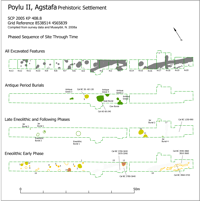Kp 408.8
References: Museyibli 2008a; Taylor et al. 2010
Archive files
Reports:
Dating | Obsidian [PDF] | Charcoal [PDF]

Poylu II (408.8) excavation plan
Evidence: Eneolithic | Bronze Age | Iron Age | Antique | Albanian | Medieval | Post-Medieval
Kp 408.8
References: Museyibli 2008a; Taylor et al. 2010
Archive files
Reports:
Dating | Obsidian [PDF] | Charcoal [PDF]

Poylu II (408.8) excavation plan
The site lies on the southern flood plain of the Kura River. This was a deeply stratified site, with the oldest deposits being up to 2m below the modern ground surface. Part of the depth of material over the site may have been related to flooding from the Kura, although it is approximately 1km to the north. The Eneolithic phases of the site were identified as being in two horizons, separated by a deposit of soil up to 100mm thick separating stone surfaces within which cultural material and animal bones were incorporated. These could be interpreted as roadways or working surfaces. The remaining features consist of storage pits and hearths with no evidence of walling recorded on the site. Burials featured in the upper horizon, and were a mixture of inhumation and jar burial. It is likely that some of the cut features result from the later Eneolithic phase, and could result from intrusive pits from later periods, but filled with Eneolithic material.
The cultural material from the site is very similar to that from Boyuk Kasik and the two sites can be regarded as broadly contemporary, although Boyuk Kasik has slightly earlier radiocarbon dates.
© Internet Archaeology/Author(s)
University of York legal statements | Terms and Conditions
| File last updated: Fri Jun 17 2011